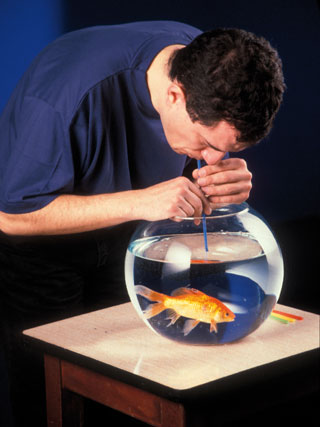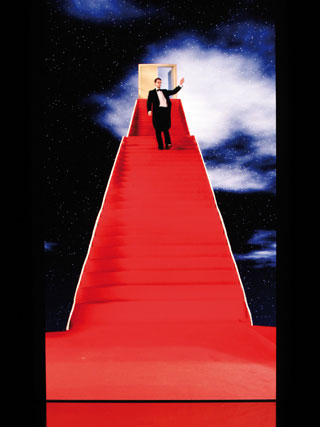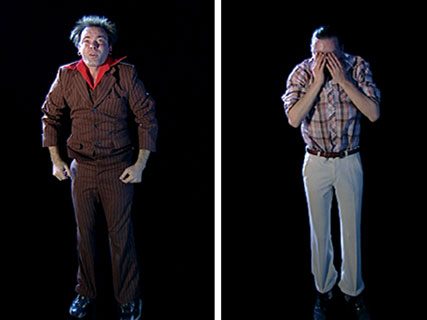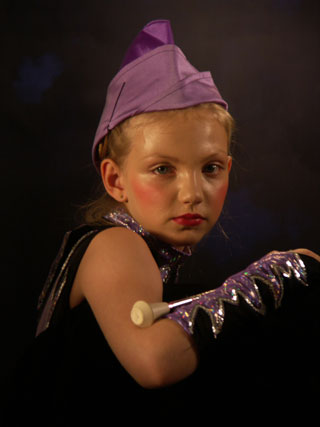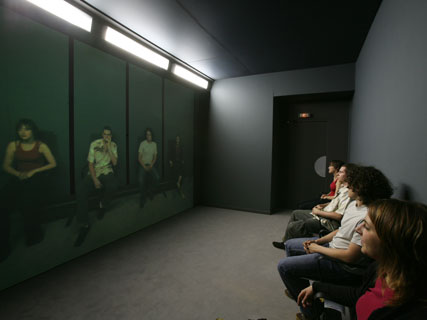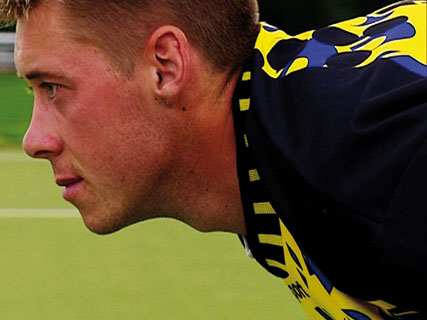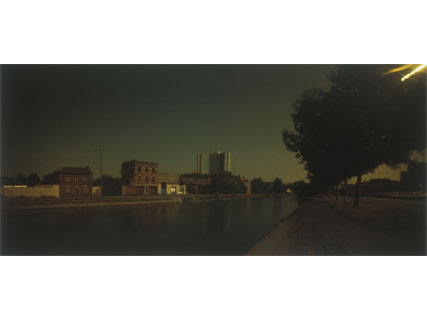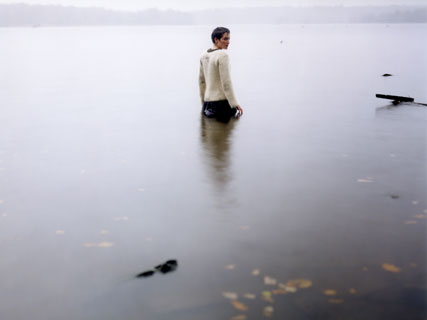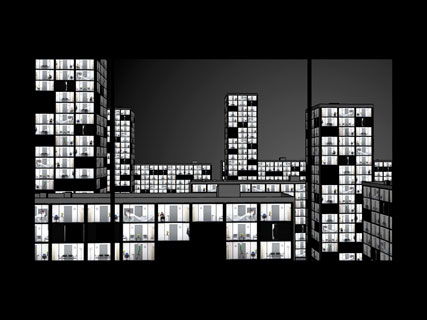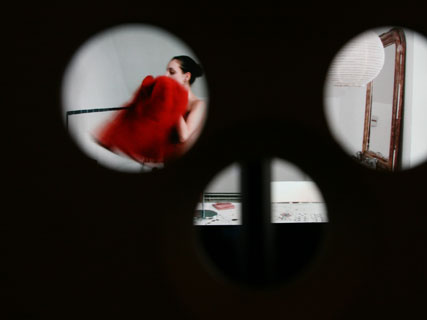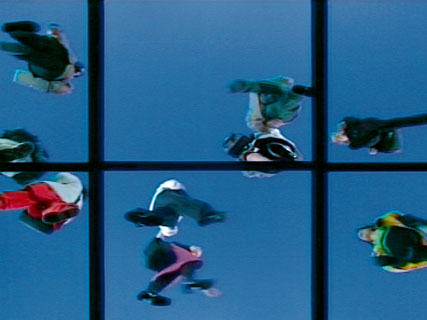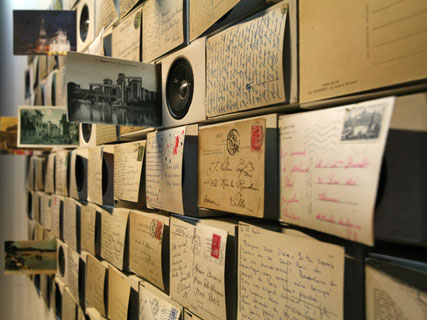The National Studio of Contemporary Art, based in Tourcoing, is celebrating its tenth anniversary with an exhibition entitled “Territoires de l’Image” that extends as far as the cities of Lille, Valenciennes, Lens and Bethune. Director Alain Fleischer has entrusted Madeleine Van Doren with this anniversary exhibition of the structure, which by dint of its uniqueness incites comparisons such as the “Electronic Bauhaus”, “The Ircam of Visual Arts” or the “High-Tech Villa Médicis”!
 A
A young woman sitting at the welcome desk to the
Fresnoy on this November day admits to being a little “disturbed” by the work that is facing her. It is a video sequence that was conceived in 1999 by patrickandrédepuis1966 who was in the first graduating class (1997/1999). What he is showing here is “Death of a Goldfish”. The shots are close-up and everything appears to have been meticulously prepared. A fishbowl full of water is set on a table. Inside the bowl a goldfish is swimming about, which is neither a pet nor really appreciated for its meat. Outside the bowl spare weapons are lined up: they are red, green, blue and yellow straws. As for the artist, he begins the combat, which appears to be a foregone conclusion, by drinking his adversary’s water through a straw. The sequence lasts the time it takes to consume the nine litres of water, which is roughly an hour. His pauses increase and get longer as the precious liquid inexorably disappears. As for the fish, he doesn’t know it’s the end until there is no more water. But it is too late. It tries to escape by writhing about and jumping, while the performer, who is also feeling unwell, seals up the exit. This performance amuses children while parents reassure themselves by saying that the fishbowl was filled up again once the camera was shut off. But who really cared about the death of a goldfish at the end of the 1990’s when war was raging on the doorstep of Europe? “At a time when other combats, that were also foregone conclusions, had nevertheless to be fought”. This action, over and above the politics that patrickandrédepuis1966 stresses, evokes the “workshop” performances of the 1960’s that were produced by performance artists who became video-artists. But what are they today in an era where a multitude of actions, often less radical, are accessible via YouTube? Or if you type in “patrickandrédepuis1966” on the cyberspace of the Web 2.0 (on the You Tube site for example) and the server responds with “No video found for patrickandrédepuis1966”, it means that museum space is still alive and well. A word of caution though: don’t try drinking nine litres of water at home!
patrickandrédepuis1966,
“Death of a goldfish”,
1999.
 A
Andy Warhol said it: “In the future, everyone will be world-famous for fifteen minutes”, but
Hakeem B, who graduated from the Fresnoy last June, has decided not to wait. The video installation “Thank you for all”, where he imagines that he is being adulated by everyone, was presented in Béthune in the director’s office of a former Banque de France, which has become a production and diffusion centre for visual arts called
Lab-Labanque. One discovers a ladder leaning up against a partition. But it is still too early to grasp what the artist is symbolising with this reduced model object – social ascension that is at times long and difficult. On the other side, on the screen, the décor is so artificial it could be from a Federico Fellini film like “E la nave va” (And the Ship Sails On). The wind blows in the night, as it does so often in the films of the Italian master. Then there is a strong light that bathes the red steps we all dream of climbing one day. This is followed by an American style announcement: “The Man, the one, the only one, put your hands together for Hakeem Beeeee”. The star then opens the door at the top of this dream ladder and climbs down the rungs, slowly, very slowly, acclaimed like a president and then climbs back up with a few bouquets of flowers to close the door again, which consequently triggers the return of the night and the gusts of wind. How soon will it be before he returns again to enjoy his few minutes of fame? As for Andy Warhol, did he ever imagine that everywhere around the world we would invent accelerated training to fabricate ephemeral stars?
Hakeem B,
“Thank you for all”,
2006.
 Hold that pose
Hold that pose
 “H
“Hold that pose, no matter what”, is what the three men cramped into this video projection seem to be thinking. One has his fists closed; another has them stuffed into his pockets, while the other covers his face with them. They all fidget, but are all determined to maintain the pose. There is nevertheless something destabilising in these presences, something abnormal. Their bodies seem to be floating in space as though possessed by some demonic force or a collective Assumption. Reading the explanation under the great nave of the Fresnoy allows us to grasp the strangeness of the postures. Alexis Destoop has reversed the images to conceive this video installation whose title is in line with his “cruelty”: “With Usura”. Over time, the men’s arms, who are suspended by their feet, give in and fall and the reversal of the image makes them fall upward. It is thus when their arms fall, swinging about above their heads, that the end of this consensual torture is indicated.
Alexis Destoop,
“With Usura”, 2001.
 “Y
“You must hold the pose for five minutes” says
Eléonore Saintagnan to her models before filming them in the photo studio of the Fresnoy in order to obtain a “Gallery of Flemish Portraits”. She cannot be exhibited at “Territoires de l’Image” because the artist is from the last graduating class, the tenth, which was called Nam June Paik. Her video installation was nevertheless shown at the Studio National last June during “Panorama 2007”. It was in Roubaix, just outside the school that Eléonore recruited ordinary people asking them to come and sit for their video portrait, with whatever background or setting they wanted. The only constraint was to remain immobile for five long, interminable minutes. The result is strange and truly evokes Flemish painting. It takes a certain time to perceive that they are not fixed images, but indeed living models within a video time frame. A few clues help us however: an arm that quivers under the weight of a gigantic wrench; a tear that slowly drips under the heat of the powerful lights that light up the image... Each person is proud to wear the costume or emblem that symbolises his or her condition or passion. Eléonore qualifies her photography as “social” at a time that is no longer that of photography and with an aesthetic that sits somewhere between Flemish painting of the 17th century and that of neighbourhood photographers of yester year.
Eléonore Saintagnan,
“Flemish portraits”,
2007.
 B
But let’s go back to “Territoires de l’Image” in Valenciennes, where Cyprien Quairiat suggests we pose for the camera in a reconstructed “Waiting Room”. Four seats face four video projections and since it is difficult, even impossible to deal with a participative work without doing so in the first person, I sit down and wait. It seems to me that something is missing, but what? Undoubtedly it is the coffee table covered in uninteresting magazines that generally allow us to occupy ourselves in this decidedly uncomfortable situation. So all that is left me is to observe. I think I recognise one of the people waiting in the image. It is indeed her, the mediator who I met at the entrance who has just sat down next to me. So we are waiting together when all of a sudden I too appear in the projected image. It is then Aurelie, the mediator’s turn to reappear in the other half of the waiting room that is in front of us. Our virtual doubles act twenty-five seconds later, so we see ourselves in the past while speaking in the present. I take the time to try to adjust my posture, anticipating an imminent future. These participative installations need to be experienced rather than recounted and back again in my office, I found “My Position” again by Dan Graham where the American artist talks about his experiments with perception in the 1960’s using video loops and delays. There are artistic issues in fact that are born of media and technology before they become universal.
 Time stretched
Time stretched
 W
We now leave Valenciennes for a moment to go to Lens, one of these towns where we often only know the name of the stadium, in this case, the Bollaert. It is in fact a football game that Laurent Grasso shows us at the Maison Syndicale des Mineurs, but it is a match that is literally transcended by the camera. The video sequence is called “Missing Time”. All the players are frozen in their actions for 4’30, as though petrified. Only the camera moves and evolves with tracking shots, curves and counter curves. Video game players know this other space-time well and call it “Bullet Time”, while cinephiles will recall Matrix’s extreme permutation of time. But here there is no technological one-upmanship, neither through the use of a 3D motor in real time nor through a multiplication of shots. The wind blows and makes the player’s jersey vibrate gently, who is still holding the pose. Time seems to have been stretched without its nature really being affected. The principal actor of the scene is none other than the camera. Laurent Grasso has been imbued with the myth of “missing time” inherent in the study of UFO’s before controlling the camera of which he later says “it films our reality in a time that only exists in its dimension and which is not human”.
Laurent Grasso,
“Missing time”,
2002.
 T
This phrase of Leonardo da Vinci was written in the Atlantic Codex: “Here the figures, here the colors, here all the images of every part of the universe are contracted to a point, what a point is so marvelous". Thus in 1515 the Italian master described the principle of the “Camera Obscura” which Christine Felten and Véronique Massinger are deploying here. The title “Canal Caravana Obscura”, of this series of photographs is rich in information. “Canal”, because the subject is the Roubaix Canal, “Caravana”, evokes the caravan that the authors have transformed into a “camera obscura”. It is certainly not by chance that we discover this series of landscape photographs dating from 1998 at the
Palais des Beaux Arts in Lille because a painting, which is exhibited on the floor above is attributed to the workshop of Antonio Canal, who was called Canaletto. Canaletto also used the same device to represent the canals of Venice two centuries earlier. The water of the Roubaix Canal as revealed by Christine Felten and Véronique Massinger is like a sea of oil. It evokes the flat expanses of water taken by the first photographers whose exposure time annihilated any possibility of waves or even of ripples. Time here is stretched to exclude any presence, whether it is human or mechanical and is reduced to a spectral state.
Christine Felten
& Véronique Massinger,
“Canal Caravana Obscura”,
1998.
 Stagecraft
Stagecraft
 W
Who in the broad world of photography who meet in Arles each year, failed to notice the photo by
Laura Henno, who won the Prix Découverte at the Rencontres Internationales de la Photographie last July? Its title, “Freezing”, confirms that it was cold on this misty morning on a site near Valenciennes, which the gallery owner of l’
H du Siège tells us is called Mare à Goriaux. The water, which has a milky look, blends in with a cotton batten sky on the horizon. Then there is this young woman who is in the water up to her hips wearing clothing that would indicate it is not swimming weather. Everything here, from the model to the piece of wood sticking out of this water that is so calm, seems to be participating in a stage setting that raises more questions than it answers. What is she thinking as she looks off into the distance? What is the reason for her having wandered here, to the edge of the world? Is she going to wade deeper into this troubling water of the Mare à Goriaux?
Laura Henno,
“Freezing”, 2004.
 B
But let’s go back to the former Banque de France in Béthune where the staging in the video installation “Night City” by Johan Berard, is meticulously structured. The meeting room has been transformed into one of the most ordinary offices imaginable that is seen from the outside through a bay window. A telephone emits ambient music; a chair allows you to sit down and a screen to observe the multitude of playlet’s that have been filmed on this same spot. The point of view in the frame of the screen could be that of a window cleaner in a business district. The camera moves laterally, progressively revealing the nocturnal life of those who never stop working, even after night has fallen. Here we see a meeting with hurried men in ties, there a woman exercising during a short break. At times the screen is black and undoubtedly shows that the occupant is “out for a meeting”. For the window washers from Manhattan to Shinjuku, from La Défense to Hong Kong, it’s “Play Time” every evening.
Johan Berard,
“Night City”, 2006.
 The intimate
The intimate
 S
Some video and sound installations at “Territoires de l’Image”, allow one to observe, to listen or to read things that are intimate. In the video installation “Wash Room” by Antonia Armelina Fritche, at first one only perceives the sounds emanating from a structure that only reveals its contents to the most curious. Visitors are in fact obliged to peek through the keyhole, which turns them into voyeurs. The interior decor is that of a bathroom inhabited by an invisible presence whose feminine contours can only be detected with difficulty. Only the mirrors give us fragments of the body where skin is progressively revealed by the water, but which a towel then erases. Though it is easy to follow her movements as she picks up visible objects, she is only really revealed to us when she washes herself, disappearing again by drying herself. She remains invisible until she once again seizes the showerhead to shower herself.
Antonia Armelina Fritche,
“Wash Room”, 2006.
 A
All of us have at one time or another dreamed of being able to read another’s thoughts and that is precisely what
Magali Desbazeille and Siegfried Canto make possible with the interactive installation “You Think, Therefore I Am”. They give us the illusion that the floor we are moving about on is nothing more than a glass partition that separates us from an upside down world within which men, women and children are walking about as well. We hear their thoughts by entering into contact with their video projected image and following them allows us to know about their concerns of the moment. The technology that has been integrated for this installation, which brings together video cameras, data bases and other applications, is similar to that used by video surveillance companies. But here it is in the service of the imagination functioning around a universal dream and a secret desire that since the beginning of time have contained the voyeur that lies dormant in us.
Magali Desbazeille
& Siegfried Canto,
“You think therefore I am”,
2000.
 L
Lastly there are the ninety-six postcards that Cléa Coudsi has brought together in her sound installation called “Bien des choses” (Lots of Things), a piece that opens up in stages. From afar one is at first seized by the visual aspect of this assemblage of cards whose surfaces are more or less yellowed, depending on the time they have been kept locked away. Closer up, an array of details as in a painting, attracts our attention. This one was sent from Monaco to someone living in the North. That one is stamped and was perhaps read by the postman. One is devoid of any souvenir. Another is entirely covered in writing that is hardly legible. Here someone used a crayon, there a quill. Sound extracts start up when you turn the cards around to look at the pictures of historical monuments, the seaside, valleys and mountains. There are voices, which are at times faithful to the text on the other side, sometimes recounting stories of memories, always in a monotonous voice. Aurélie the mediator, seems to have read them all, looked at them all and listened to them all. She also admits to having turned them all around at once with the help of a few children in order to set off all the “voice offs” simultaneously; undoubtedly to show them that a work that participates in misappropriation is itself made to be misappropriated.
Cléa Coudsi,
“Bien des choses”,
2006.
 I
I have now arrived at the end of this “post card” from the “Territoires de l’image” and for those who missed all these exhibitions, you need only wait for “Dans la nuit, des images”, an event that has been booked by the Ministry of Culture to mark France’s takeover of the European Presidency. This other anniversary at the end of 2008 will celebrate the graduation of the twenty-four artists of the tenth Fresnoy graduation under the immense glass roof of the Grand Palais. All the best.
Written by Dominique Moulon for "Images Magazine" and translated by Geoffrey Finch for "newmediaart.eu", this article is also available in French on "nouveauxmedias.net".
